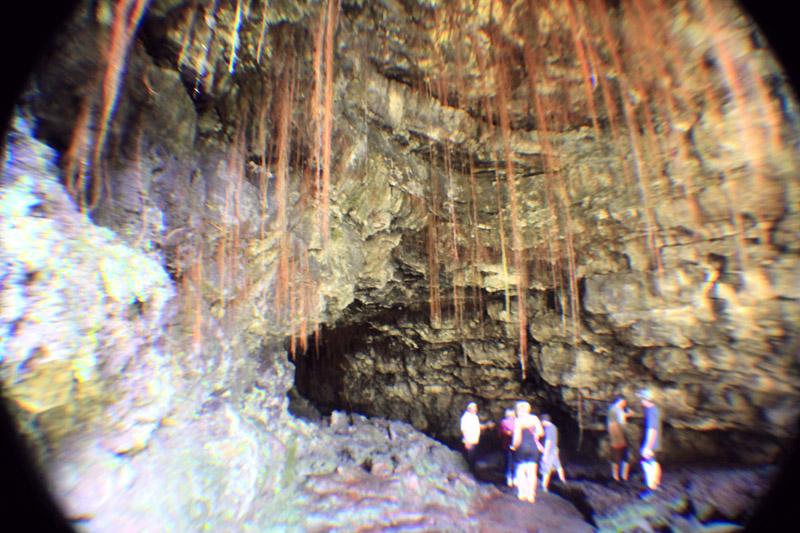
Just up the mountain from Hilo town sits one of the lesser-visited geological formations of the area. Kaumana cave is a 25 mile long lava tube that is accessed via a skylight created when part of the cave ceiling collapsed more than a hundred years ago, leaving two gaping cave doorways exposed to the outside world.
This lava tube was created by a lava flow from Mauna Loa in 1881 that was advancing toward the city of Hilo. History tells us that Princess Ruth Ke’elikolani made the journey to Hilo from Honolulu and stood praying in front of the creeping molten rock asking the goddess Pele to spare the city. The flow stopped just 1.3 miles from downtown and today Hilo continues to stand, defeated by neither lava nor tsunami.
Lava tubes are formed when a surface flow begins to cool around the edges, forming walls on its sides which over time becomes a trough, and then a tube as the center stays hot and the outside crusts over. As more lava flows through this pipe the center remains hollow and can transport molten rock underground for dozens of miles before exiting at the surface far, far away. Because of Hawaii’s volcanic composition there may be thousands of undiscovered lava tubes scattered beneath the surface of the island.
Kaumana cave is just one example of the spectacular caving to be had on the island. Easily accessible, the cave is less than a ten minute drive from Hilo town. Parking is across the street and the place is usually empty. A concrete stairway descends from street level into the wide pit, which looks just like the surrounding area, but 20 feet lower. Two openings present themselves. To the right is the larger opening, with a cavernous space that tapers down to a skinny corridoor some 100 feet back before going dark. This room is a great place to sit on a boulder and enjoy the cave with plenty of sunlight. To the left is another entrance. This one has more twists, squeezethroughs, and variety, but it plunges into total darkness after about 30 feet. Either way, if you plan to venture past the limit of the sunlight you’ll need to bring a powerful flashlight.
Traveling deeper, one will notice the copious tree roots hanging from the ceiling. Deep within the cave these roots provide the only source of nutrients for life and support an entire ecosystem all its own beneath the surface. Many endemic cave insects can be found in these depths including crickets, moths, spiders, arthropods, and isopods.
The cave interior is cool and wet. If you plan to stay in for a while you may want to bring a raincoat (especially if it’s raining outside) because the ceiling drips quite frequently in many places.
Most visitors are content just to explore the pit and cave entrances, and indeed one can easily spend an hour just looking at the plants and rock formations in the sun. This is a great place to stop and eat a packed lunch on your way to Hilo or Mauna Kea along Saddle road. There are restrooms and picnic tables topside, but for the more adventurous, a picnic inside the main cavern is a meal that won’t soon be forgotten.
Kaumana cave is rich with natural beauty, but just like any other part of the natural world, it can be dangerous as well, and humans can have a major environmental impact. Those planning to explore the cave depths should follow some simple rules:
-If it’s alive, DON’T TOUCH IT. Most cave life lives around sunlit entrances, but anything living found within cave depths is extremely fragile. Away from the sun there are fungi and bacteria that can be killed with a single touch.
-Bring a buddy. There are no lights or supervision of any kind here, so if something happens to you inside no one is going to come get you. Be smart.
-Flashlights and good closed-toed shoes are mandatory. Bring spare batteries and a backup light so there’s no chance of getting caught in the dark.
Why Go to Kaumana Cave?
For a uniquely Hawaiian subterranean experience that far exceeds the beauty of Thurston Lava tube in the volcano park and for an exciting adventure close to Hilo that can be as long or short as you like, Kaumana is the place.
